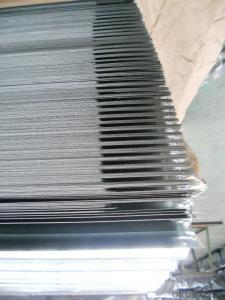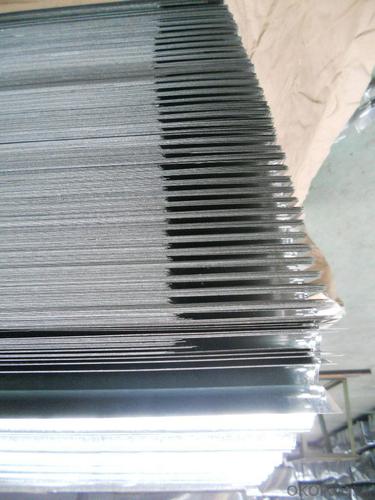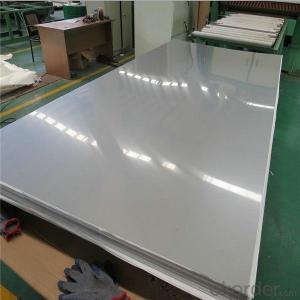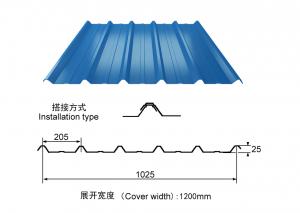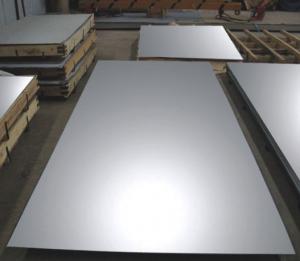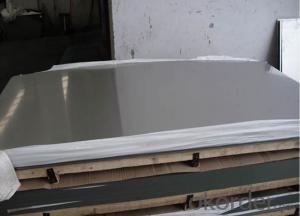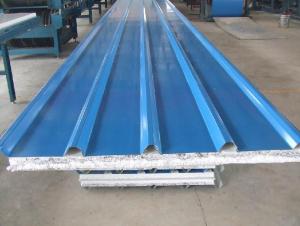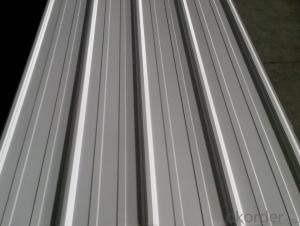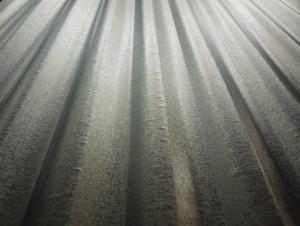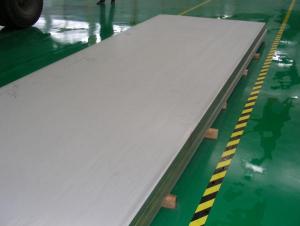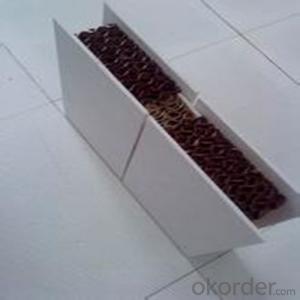Corrugated steel sheet
- Loading Port:
- China Main Port
- Payment Terms:
- TT OR LC
- Min Order Qty:
- -
- Supply Capability:
- -
OKorder Service Pledge
OKorder Financial Service
You Might Also Like
Corrugated steel sheet is the colored steel plate which has been wave formed with the cold rolling treatment, trough especial coated dispose, the color coated steel panel’s guaranty is 12-15 years.
It has been widely applied on civil construction like storerooms, special building roof and walls of wide-span steel structure building and so on.
Pressing steel panel with the clear line, and many colors for choice, suitable for any different building style materials, achieving satisfy effects;
Pressing steel panel can be freely incised, it can satisfy the especially designing demands. It apply on convenient construction, and anti-seismic performance, fire proof, waterproof, free of maintenance, ect.
CORRUGATED HOT DIPPED GALVANIZED STEEL SHEETS
THICKNESS TOLERANCE: (+/-0.01mm)
ZINC COATING: 50g/m2
WIDTH: 900mm (AFTER FORMING)
STANDARD:JIS G 3302, SGCH
SURFACE:REGULAR SPANGLE, CHROMATED, DRY
PACKAGE: 2- 3 TON/PALLET
SPECS: 0.18mm X 900mm X 2000mm
Specifications
1. Zinc coating :60-180g( as required)
2. thickness:0.14-0.80mm
3. width:700-1250mm( 750mm,900mm,1215mm,1250mm,1000mm the most common)
6. surface:regular/mini/zero spangle, chromated, skin pass, dry etc.
- Q: Are lead contained in galvanized steel plates and plain steel plates?
- Steel plate is made of molten steel, cooled and compressed into flat steel.
- Q: How do steel sheets perform in terms of vibration resistance?
- Steel sheets have excellent vibration resistance due to their high stiffness and density. The rigidity of steel enables it to dampen vibrations effectively, making it a reliable choice for applications where vibration control is crucial.
- Q: Can steel sheets be used for making HVAC ducts?
- Indeed, it is possible to utilize steel sheets in the construction of HVAC ducts. Owing to its robustness, longevity, and fire-resistant attributes, steel is widely employed as a material for fabricating HVAC ductwork. To construct the ductwork, steel sheets are typically sliced, shaped, and fused together, enabling the efficient distribution of air throughout a structure. By employing steel sheets, the ducts can endure the elevated temperatures and pressures associated with HVAC systems, all while retaining their structural integrity. Furthermore, steel ducts exhibit increased resistance to harm caused by pests, moisture, and the growth of mold when compared to alternative materials. In summary, the reliability and capacity to meet the requisite performance standards make steel sheets a fitting choice for the production of HVAC ducts.
- Q: How do steel sheets perform in terms of weather resistance?
- Steel sheets are highly weather-resistant due to their inherent strength and durability. They can withstand various weather conditions such as rain, snow, extreme temperatures, and UV exposure without deteriorating or losing their integrity. Additionally, steel sheets are resistant to corrosion, which further enhances their longevity and ability to withstand harsh weather conditions.
- Q: Are the steel sheets suitable for welding or fabrication purposes?
- Steel sheets are indeed appropriate for welding or fabrication purposes. Steel is a versatile material that finds application in a wide range of industries, such as construction, automotive, and manufacturing. When it comes to welding and fabrication, steel sheets serve as a sturdy and long-lasting foundation. They can be easily manipulated through cutting, shaping, and welding techniques like arc welding, MIG welding, or TIG welding. Steel sheets possess outstanding structural integrity and can endure extreme temperatures and mechanical strain during the welding or fabrication process. Moreover, they are obtainable in various thicknesses and grades, enabling customization in accordance with particular welding or fabrication prerequisites.
- Q: Do steel sheets have any magnetic properties?
- Yes, steel sheets can have magnetic properties. The magnetic properties of steel sheets depend on the composition and processing methods used. Some steels, such as carbon steels, are not inherently magnetic, while others, such as stainless steels, can exhibit magnetic behavior.
- Q: What are the different manufacturing processes for steel sheets?
- There are several manufacturing processes for steel sheets, each with its own unique characteristics and applications. Some of the most commonly used processes include: 1. Hot rolling: This is the most common method for manufacturing steel sheets. The process involves heating the steel billet or slab to a high temperature and then passing it through a series of rollers to reduce its thickness. The hot rolling process results in sheets with a smooth surface and excellent mechanical properties. 2. Cold rolling: In this process, the steel is rolled at room temperature, resulting in sheets with a higher degree of dimensional accuracy and surface finish. Cold rolling is often used to produce sheets with tight tolerances and improved surface quality. 3. Galvanizing: Galvanizing is a process that involves coating steel sheets with a layer of zinc to protect them from corrosion. The sheets are immersed in a bath of molten zinc or are electroplated with zinc, forming a protective barrier that extends the lifespan of the steel. 4. Coating: Steel sheets can also undergo various coating processes to enhance their properties or appearance. Examples include powder coating, where a dry powder is applied electrostatically and then cured under heat, and paint coating, where a liquid paint is applied to the surface and dried. 5. Pickling: Pickling is a chemical process used to remove impurities such as rust, scale, and oxides from the surface of steel sheets. The sheets are typically immersed in an acid bath, which dissolves the unwanted materials, leaving behind a clean surface. 6. Cutting and forming: Once the steel sheets are manufactured, they can be further processed through cutting and forming operations. Laser cutting, plasma cutting, or shearing can be used to cut the sheets into desired shapes and sizes. The sheets can also be formed into various products using techniques such as bending, deep drawing, or roll forming. These are just a few examples of the different manufacturing processes for steel sheets. The choice of process depends on factors such as the desired sheet properties, surface finish, and intended application.
- Q: Are steel sheets available in different colors?
- Yes, steel sheets are available in different colors.
- Q: Can steel sheets be painted or powder-coated after installation?
- Yes, steel sheets can be painted or powder-coated after installation. Painting or powder-coating steel sheets after installation is a common practice to enhance their aesthetic appeal and provide additional protection against corrosion. The process involves thoroughly cleaning the steel surface, applying a primer to ensure good adhesion, and then applying the desired paint or powder coating. This can be done on-site or in a specialized facility, depending on the size and complexity of the steel sheets. Additionally, it is important to ensure that the chosen paint or powder coating is suitable for exterior use and can withstand the environmental conditions to which the steel sheets will be exposed.
- Q: How do steel sheets handle thermal conductivity?
- Steel sheets have a relatively high thermal conductivity, which means they are efficient in transferring heat. This property allows steel to quickly absorb and distribute heat across its surface. When exposed to a heat source, such as a flame or hot object, steel sheets rapidly conduct the heat throughout its structure, resulting in uniform heating or cooling. This makes steel sheets suitable for applications that require heat transfer, such as in the construction industry for radiant heating systems or in manufacturing for heat exchangers. The high thermal conductivity of steel also makes it a preferred material for cookware, as it ensures even heat distribution and efficient cooking. However, it is important to note that steel's thermal conductivity can also make it prone to heat loss in colder environments, requiring appropriate insulation measures to maintain desired temperatures.
Send your message to us
Corrugated steel sheet
- Loading Port:
- China Main Port
- Payment Terms:
- TT OR LC
- Min Order Qty:
- -
- Supply Capability:
- -
OKorder Service Pledge
OKorder Financial Service
Similar products
Hot products
Hot Searches
Related keywords
